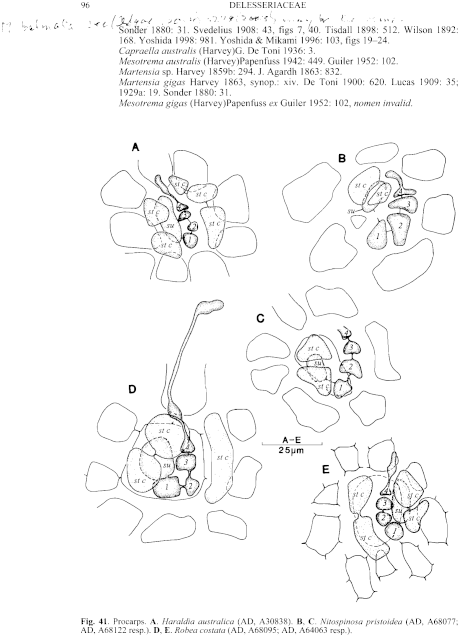|
|
|
|
|
|||||||||||
|
Electronic Flora of South Australia Species Fact Sheet
Phylum Rhodophyta – Family Delesseriaceae
Thallus (Figs 39A, 40A) erect, delicate, medium to dark red, 3–10 cm high, much branched marginally and more or less complanately, most branches (2–) 3–8 (–15) mm broad, margins linear to convolute with rounded to pointed apices and occasional small proliferations, developing a distinct midrib, wings lost near the base leaving a short stipe; veins absent. Holdfast of clumped rhizoids, becoming fibrous (Fig. 39B); epiphytic, commonly on Nitospinosa pristoidea and Phacelocarpus peperocarpos. Structure. Growth marginal (Fig. 39D), with occasional distinct apical cells (Figs 39C, 40B, C) but many branches with marginal growth from sunken apical cells and with some cells dividing anticlinally; cell divisions intercalary and irregular, without distinct axial or second-order cell rows; surface cell arrangement irregular but cells often in longitudinal lines (though not forming veins), cells angular, 20–45 µm broad and L/D 1–2. Blades monostromatic and 45–120 µm thick, the midrib (Fig. 39E) tristromatic and 90–200 µm thick and then polystromatic (Fig. 39F) and 250–300 µm thick; cortical cells equivalent, of similar size to primary cells. Cells multinucleate; rhodoplasts discoid.
Reproduction: Gametophytes dioecious. Procarps (Fig. 41D, E) scattered, developing on opposite sides of the blade from a primary cell which cuts off 2 elongate cells more or less parallel to the branch length, one dividing into 2 as a group of cover cells and the other (supporting) cell bearing a carpogonial branch and a 2-celled sterile group, these and the cover cells lying on each side of the 4-celled carpogonial branch (Figs 39G, 40D). Carposporophyte (Fig. 40E) with a small basal fusion cell and moderately branched gonimoblast of short cells with large, clavate to ovoid, terminal carposporangia 35–65 µm in diameter, replaced from below. Cystocarps (Fig. 39H) scattered, hemispherical, 0.7–1.3 mm across, ostiolate; pericarp 90–110 µm and 4–7 cells thick, with no or very slight collar. Spermatangial sori (Fig. 40F) on blades, elongate-ovate, (200–) 400–1000 µm across, with the primary cells producing a layer of initials which cut off outer elongate spermatangia.
Tetrasporangial sori (Fig. 40G) ovate, scattered, mainly on lateral blades or wings, rounded to elongate, (300–) 500–1200 µm across and 180–360 µm thick, with tetrasporangia in 2 layers, cut off from inner cells (Fig. 40H) of cortical chains 4–6 cells long and covered by outer cortical cells, subspherical, 60–110 µm in diameter.
Type from Port MacDonnell, S. Aust., on Nitospinosa pristoidea, drift (Womersley, 4.iv.1999); holotype in AD, A68095.
Selected specimens: N of Cape Thomas, Guichen Bay, S. Aust., on Nitospinosa pristoidea, drift (Womersley, 24.viii.1960; AD, A24389). Robe, S. Aust., on Ballia callitricha, drift (Womersley, 29.viii.1949; AD, A10913) and on N. pristoidea, drift (Womersley, 2.iv.1999; AD, A68099). Stinky Bay, Nora Creina, S. Aust, on N. pristoidea, drift (Womersley, 19.viii.1957; AD, A21274) and (Mitchell, Nov. 1965; AD, A29710). 2 km NW of Blackfellows Caves, S. Aust., on N. pristoidea, drift (Womersley, 24.xi.1992; AD, A61777). 1.3 km off Middle Point, Cape Northumberland, S. Aust., on Phacelocarpus peperocarpos, 15 m deep (Shepherd, 13.ii.1976; AD A47018). Crawfish Rock, Westernport Bay, Vic., on hydroid(?), 8 m deep (Watson, 26.iv.1969; AD, A34372). Pirates Bay, Eaglehawk Neck, Tas., on P. peperocarpos, 9–12 m deep (Gowlett-Holmes, 31.x.1994; AD, A64063). Cathedral Cave, Waterfall Bay, Tas., on P. peperocarpos, 6–15 m deep (Archer, 3.iv.1999; AD, A68149). Crayfish Point, Taroona, Tas., on P. peperocarpos, 0–6 m deep (Sanderson, 29.v.1992; AD, A61758).
Distribution: Cape Thomas, Guichen Bay, to Cape Northumberland, S. Aust; Crawfish Rock, Westernport Bay, Vic., and SE Tasmania.
Taxonomic notes: Robea costata is named for the prominent costa shown by most plants.
References: The Marine Benthic Flora of Southern Australia Part IIID
Publication:
Womersley, H.B.S. (24 February, 2003)
The Marine Benthic Flora of Southern Australia
Rhodophyta. Part IIID. Ceramiales – Delesseriaceae, Sarcomeniaceae, Rhodomelaceae
Reproduced with permission from The Marine Benthic Flora of Southern Australia Part IIID 2003, by H.B.S. Womersley. Australian Biological Resources Study, Canberra. Copyright Commonwealth of Australia.
Illustrations in Womersley Part IIIA, 2003: FIGS 39, 40, 41D, E.

Figure 39 enlarge
Fig. 39. Robea costata (A, C–G, AD, A68095; B, AD, A68099; H, AD, A29710). A. Habit of type on Nitospinosa pristoidea. B. Fibrous holdfast. C. Apex, with an apical cell almost level with margin. D. Apex without clear apical cells. E. Transverse section of blade, thicker centrally. F. Transverse section of midrib. G. Procarp with an undivided cover cell (above) and 2 sterile cells (Below). H. Cystocarps, surface view.

Figure 40 enlarge
Fig. 40. Robea costata (A–E, G, AD, A64063; F, H, AD, A68149). A. Habit on Phacelocarpus. B. Branch apex with minute spines with apical cells. C. Frond margin with apical cells (arrows), one on a small spine. D. Procarp with a carpogonial branch and cover sterile cells (out of focus). E. Section of a cystocarp. F. Blade with spermatangial sori. G. Tetrasporangial sorus. H. Transverse section of tetrasporangial sori.

Figure 41 enlarge
Fig. 41. Procarps. A. Haraldia australica (AD, A30838). B, C. Nitospinosa pristoidea (AD, A68077; AD, A68122 resp.). D, E. Robea costata (AD, A68095; AD, A64063 resp.).

|
Email Contact: State Herbarium of South Australia |

|